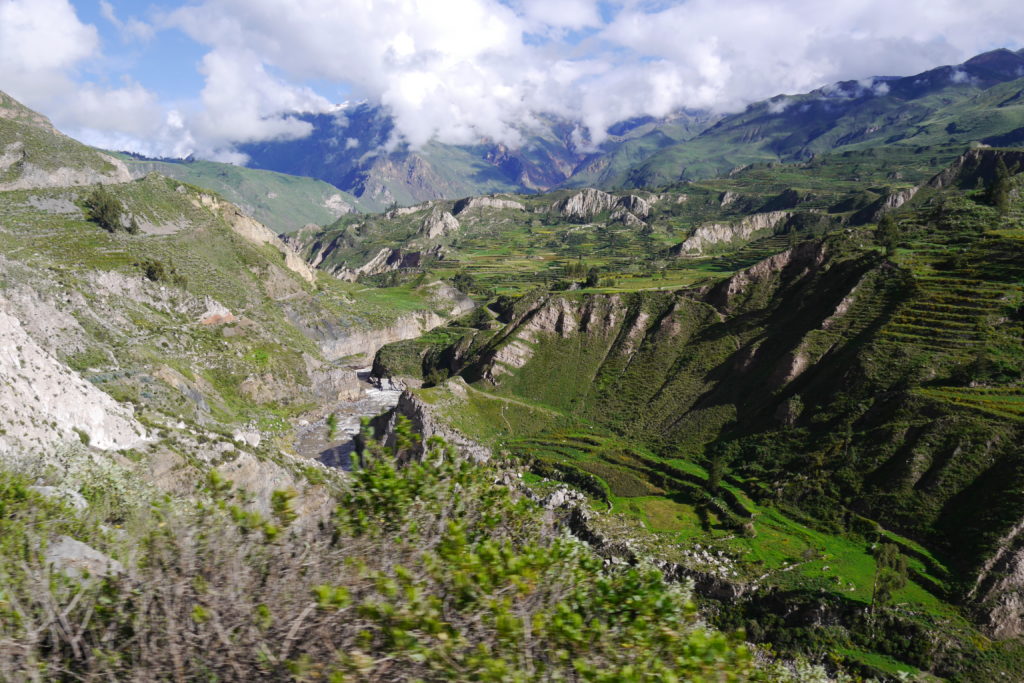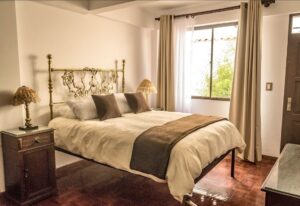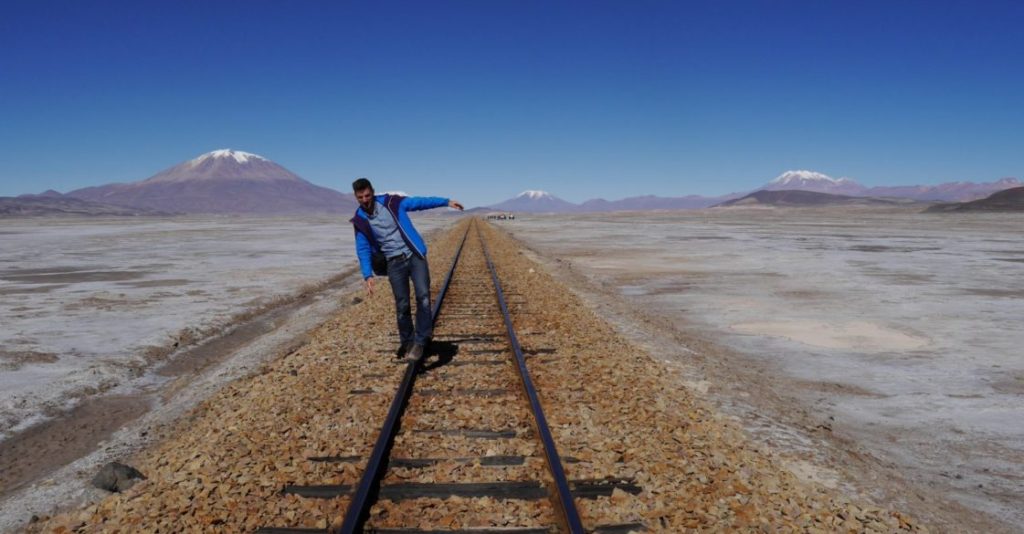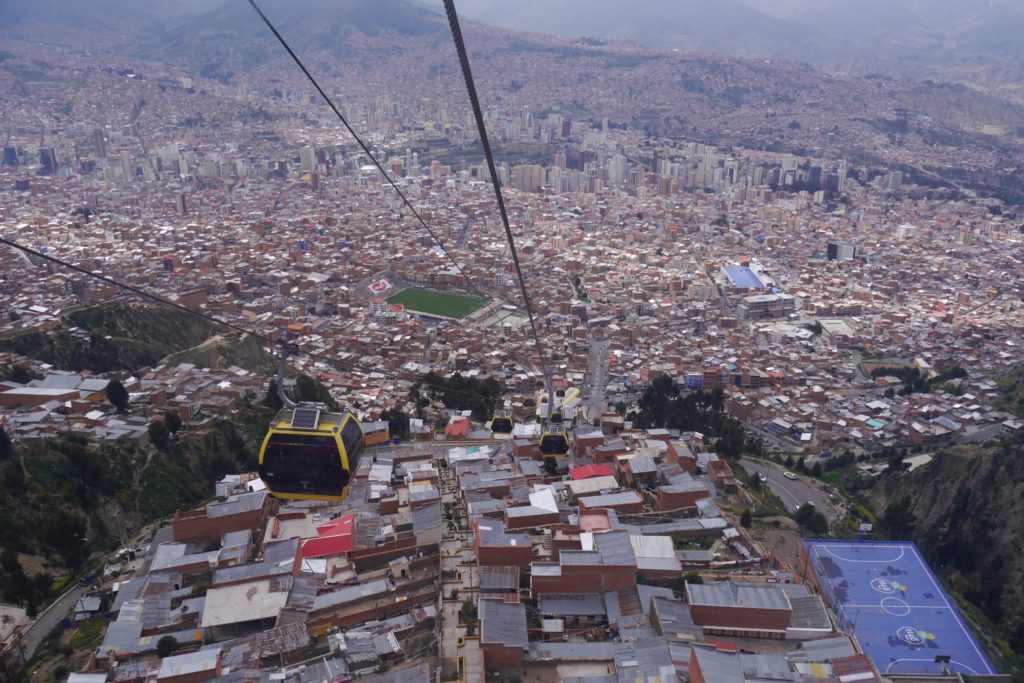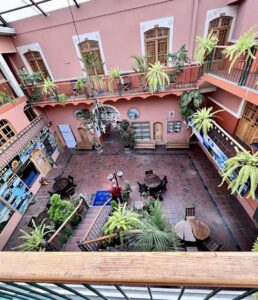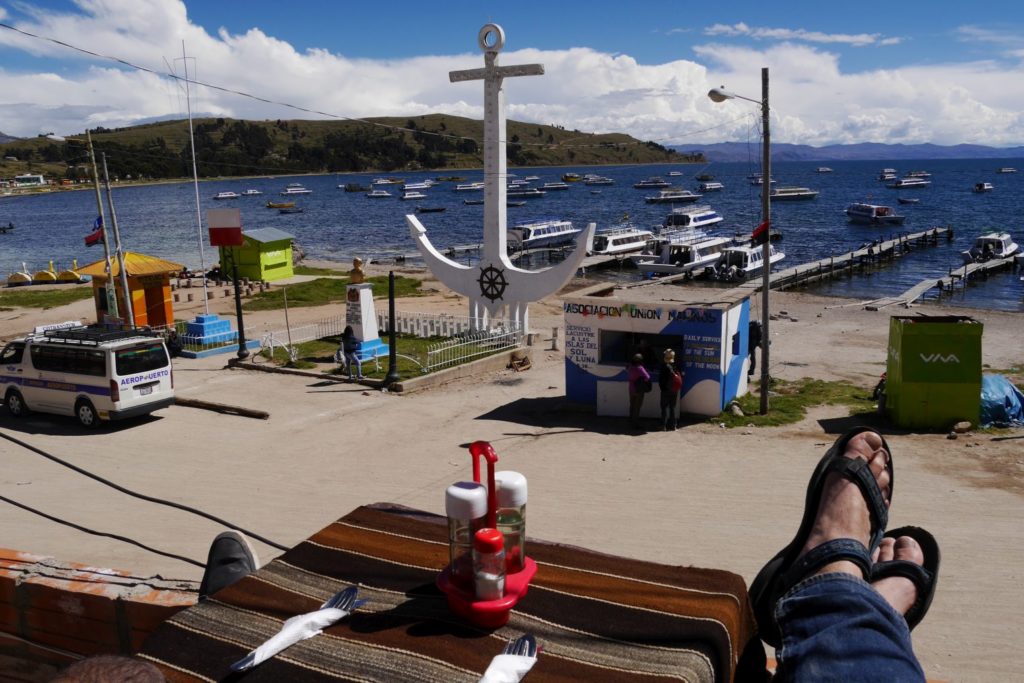Backpacking Bolivia and Peru was a real adventure. The cities and landscapes in this area are just unreal and made this 3 week Bolivia and Peru itinerary to an amazing trip. For our first backpacking trip in Latin America, we took on the typical gringo trail through Bolivia and Peru. We would like to tell you about our itinerary through Bolivia & Peru and the experiences we made on our backpacking tour in this travelogue.
We booked our return flight from/to Lima (Peru) and from there we traveled by train, plane and especially buses through the two Spanish-speaking countries. The highlights of the trip were certainly Machu Picchu in Peru and the much less known (but no less spectacular) Salar de Uyuni in Bolivia.
Itinerary Bolivia and Peru
On a Google Maps map I have marked the individual route points. On this map you can see our exact route through Bolivia and Peru:
Backpacking Bolivia and Peru | Day 1: Arrival Lima
Our itinerary through Bolivia and Peru started in Lima. After our arrival we took a cab from the airport to the city center to go to our hostel. It was well after sunset, but we still went out to explore the old town. We had planned to continue directly the next day, because we had not really heard exciting things about this city. So we only had a few hours in the capital of Peru, but to get a first insight it was certainly a good start.
If you have more time in Lima and want to get to know the city a bit more you can do a Lima City Tour by Bus*. With this Hop-On-Hop-Off-Tour you get the best view of Lima with a panoramic bus. Discover some of the many things to see in the beautiful capital of Peru.
Panoramic Bus Tour in Lima | Check Prices*
In retrospect, the old town of Lima was quite respectable, but nothing special compared to Cusco, for example. In contrast, the district of Miraflores – which is located directly on the sea – is the complete opposite. Modern and rather western oriented with many restaurants and its own shopping center.
Accommodation in Lima
The 1900 Hostel Lima is in the city center which makes it easy to get around and visit lot of museums and the historical district. The building ist just beautiful and especially the roof top terrace is a great place to meet other travelers.
- cozy rooms
- friendly staff
- good breakfast
- free WiFi
1900 Hostel Lima | Check Prices*
Day 2: Huacachina Oasis
The next morning, we boarded a bus from the provider Cruz del Sur quite early to the Huacachina Oasis. We actually only wanted to stay there for half the day to try sand buggy riding and sand boarding and then continue on again in the evening. That’s why we hadn’t booked any accommodation.
The cab driver who picked us up at the bus station promised us that he would drive us to an accommodation where we could leave our backpacks and also take a shower as long as we booked a sand buggy tour* with him. This also cost only 15€. So we did not think long and got in with him.
Full Day Tour to Huacachina Oasis | Check Prices*
Sandbuggy Tour in the oasis
On the really fun sand buggy tour, you jet through the desert at fast speed and literally fly over slopes that you don’t even see until the last moment. We swallowed a lot of sand, but rarely had so much fun driving. The sandboarding also worked out pretty well with previous experience in snowboarding. Most of us just laid down on the board and went down the dune. Really a lot of fun!
After we got back to the oasis we had to rest and relax with an obligatory Pisco Sour (really the best drink in Peru). After our meal we explored the oasis and the surrounding area a bit. Away from the restaurants and hotels directly on the small lake it is really very dirty and you notice the influences of tourism in this otherwise very incredible dune area. Therefore, we would not recommend spending several days here. The beautiful oasis appearance is unfortunately only deceptive… but to spend an active day in the dunes you should come here in any case.
The fate does not mean well with us
Unfortunately, in the evening at the bus station we had quite bad luck with our onward journey. Bus service was suspended because the Panamericana, the only overland road in the area, was closed due to flooding. It was unfortunately in March still rainy season in Peru, and there you can also have bad luck. Nobody could tell us when it would go on.
But after we had waited for a few hours and we still had not heard anything specific, we wanted to have our prepaid tickets refunded in order to try our luck in another way. Only this is not easy without any real knowledge of Spanish. With the help of other travelers we were able to overcome the language barrier, but unfortunately we still did not get our money back. Bad luck.
Nonetheless, we had made a plan to take minibuses to the flooded bridge, somehow cross the river there, and then get on another bus on the other side and head to Arequipa. There were actually several drivers offering this adventurous route on the station forecourt. After several back and forth, this seemed too dangerous and we decided to take a room in Ica, the next bigger – very noisy and dirty – city near the oasis, and try our luck again the next day.
Since it was already quite late we decided for the first hotel (despite the almost 80€), which was of course directly on a busy road. After a more bad than right night we went to the bus station and could then also directly take a bus direction Arequipa.
Suddenly nothing works
Of course our bad luck didn’t let us go, because halfway our bus stopped in the middle of the night in a long traffic jam. When the sun was slowly rising and we had dared to get out of the bus we could look, what was the reason for the long and also already several hours lasting traffic jam.
A river had flooded a road and prevented the continuation of the journey. After a total of 8 hours of involuntary stay, excavators had dammed up the river so far that the numerous waiting vehicles could slowly drive through the still knee-high water. After a few more hours we finally arrived in Arequipa, shortly before midnight. Almost 24 hours later than actually planned.
Accommodation in Arequipa
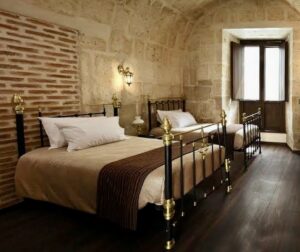 Acolpacha Tambo Boutique Hotel
Acolpacha Tambo Boutique Hotel
The Acolpacha Tambo Boutique Hotel* is the best place to stay in Arequipa. The Hotel is a historical building with modern conveniences and a lovely courtyard. You will have a delicious breakfast in a sunny spot with an amazing view to the mountain.
- excellent breakfast
- central location
- super comfortabel rooms
- amazing terrace with mountain view
Acolpacha Tambo Boutique Hotel | Check Prices*
Day 3-4: Arequipa and Colca Canyon
Unfortunately we had to skip our plan for a 2 day hike in the Colca Canyon. We just didn’t have enough time. We had asked the night porter in our hostel if we could still spontaneously make a tour into the canyon with the famous condors the next day.
With hands and feet and with the help of Google Translate we could communicate and understood that we would be picked up after about 3 hours of sleep at 4 am to be in the canyon shortly after sunrise. Sounded exhausting, but we thought… why not!
After a very bumpy ride in a minibus, we arrived in a small town near the canyon and changed to a big tour bus that drove us to the different viewpoints. The view of the canyon was really engaging, green nature as far as the eye could see. And we were also lucky for once, because the condors were not long in coming.
The special thing about the condors and the gorge itself is the thermals, with the help of which the condors can soar almost without flapping their wings for hours. A virtually heavenly sight. Unfortunately, we had no time for a hike in the gorge, but if you have more time there, then I can only warmly recommend a multi-day hike.
Multi Day Hike in the Colca Canyon | Check Availability*
Back to Arequipa
In the afternoon we took the bus back to Arequipa and visited the Santa Catalina Monastery, which is open on Tuesdays & Thursdays until 8pm and dips the complete circuit in romantic candlelight. A special experience and definitely recommended! On the way back, I had the smart idea to buy a hamburger at a little confidence-inspiring street stall. I don’t like going to fast food restaurants like McDonalds on vacation and instead try to sample local cuisine where possible.
On this day, however, I would rather not have done that. In the evening my stomach was already rumbling a bit and the following 3 days I was completely flat with a stomach bug. Thank God we had found a nice accommodation in Sucre – our next destination – so I could at least make the time in bed more or less comfortable. By plane we went quite comfortably from Arequipa via La Paz to the capital of Bolivia.
More articles on South America
Day 5-7: Sucre
We spent the next few days on our itinerary through Peru and Bolivia in Sucre. Sucre is the constitutional capital of the Andean nation, and the big city of La Paz “only” the seat of government. We had booked ourselves into the gorgeous little hotel to spent the next days. That’s where I spent most of my time, since I couldn’t get too far from the toilet.
Nevertheless, we had the opportunity to experience the charm of the city with its white shining colonial houses and the quiet little streets. Architecturally, this city really has a lot to offer. In Sucre, I was also able to experience a Bolivian hospital for the first time – it somehow didn’t get any better with me. Despite my non-existent knowledge of Spanish, I was able to communicate to some extent with hands and feet.
This was at least enough for the handing out of antibiotics and a really disgusting tasting electrolyte solution. The costs were with nearly 20€ not even so high that I would have submitted them to my health insurance abroad. And slowly things were looking better for me.
Accommodation in Sucre
The Bed & Breakfast El Jardin de su Merced* feels like a beautiful oasis in the middle of the city with a beautiful garden to relax in. Everything is so charming and comfortable that you want to stay longer.
- beautiful garden
- central location
- lovely rooms
- cozy pool area
- amazing hosts that help with everything
B&B Jardin de su Merced in Sucre | Check Prices*
Nothing works on Election Days
Nevertheless, we had imagined the day of our departure to be easier (once again): We had actually planned to take the bus to Uyuni early in the morning. As we had heard, the landscape on this trip was supposed to be so beautiful that a bus ride during the day would be quite worthwhile. But what we could not foresee… on this Sunday elections took place in Bolivia.
And if there are elections, then there should be elections. And nothing else! So it happened that our hostel father told us that on this day no means of transportation drove! No bus, no cab, nothing. People should just go and vote.
So that was it with our plan to be already in Uyuni in the evening. We tried nevertheless in the evening our luck at the bus station and thank God the bus drove toward salt desert and we could start for scarcely 7€ per person the night journey.
Thanks to the increasing altitude – Uyuni is almost 1000 meters higher than Sucre – it was increasingly cool in the bus and that you could not close the windows properly did not make the bus ride more pleasant.
Day 8-10: Salar de Uyuni
We arrived in the desert town at 3am and checked into the first available hotel with a multi-bed room. Around 6am we left our sparse dwelling to find a vendor for a jeep tour of the Salar de Uyuni. Since we had lost one day due to the elections in Sucre, we wanted to do a two-day tour instead of a three-day tour. But only 1 or 3 days were offered. Crap!
We knew actually only the salt lake from the travel guides and thought this would be enough. But thank God we decided to do the three day tour that would take us down to the deep south of Bolivia. We chose Red Planet Expeditions as our tour provider. This was one of the most expensive providers, but this seemed to be not such a bad choice for a trip into the deserted south of Bolivia. We paid just under 200 USD for 3 days including accommodation and food.
3 Day Tour Uyuni Salt Flats and Red Lagoon | Check Availability*
The first short drive took us to the railroad cemetery, which is very close to Uyuni. From there we continued into the actual salt desert. Bright white as far as you can look. There we first visited the village Colchani, where you can see how the salt from the desert is processed.
I also took a small bag home with me. Afterwards we went to the legendary salt hotel, where you can really stay overnight. However, we only made a small food stop there. From there we went on to the cactus island (Fish Island), which is the only elevation on the otherwise completely flat salt lake.
View to the Horizon
The view from the small hill reaches to the horizon. In this area we also took the obligatory salt lake pictures, which are so impressive because of the clear view to the horizon. The next stop was a small settlement in the middle of nowhere, where we spent the night in a barren building, but not without being served a rich dinner first.
The next day started early and our jeep took us past extinct volcanoes, rugged landscapes, huge herds of alpacas and to several lagoons, some with hundreds of flamingos. The highest and driest desert in the world (Siloli) was also crossed and awaited us with partly absurd rock formations before we arrived at our second accommodation, which was even more sparse than the previous one.
A sad, lonely house in the desert with an outhouse in front of it, but also with a highlight: a natural hot spring where you can bathe. And of course we didn’t let ourselves be told twice. In the middle of the night, with temperatures in the single digits, we jumped into the 35° C hot water and all we needed was a cocktail in our hands for perfect happiness.
The Southernmost Point of Bolivia
The next morning we drove to the southernmost point of our trip, the Salvador Dalí Desert on the border with Argentina and Chile. There are the highest mountains of the Andes and many geysers, hot springs and bubbling fumaroles, from which hot steam and volcanic gases are constantly emitted. An inhospitable landscape. This is how astronauts must feel on the moon.
After a few hours stay we started the long drive back (about 6h) to Uyuni. From there we actually wanted – for the sake of comfort – to return to La Paz by plane. But since a plane was not scheduled to take off until the next morning and we would not have saved any time at all, we decided to take the cheaper night bus. We spent the remaining hours in Uyuni with buying souvenirs and eating pizza and then boarded the bus around evening, which should bring us back to civilization overnight.
There was even something to eat, but since there are no really paved roads in the deep south of Bolivia, the first hours of driving became a real shaking. Eating was out of the question, because we had enough to do with holding on to the small aluminum bowls with rice and beans, so that they didn’t slide off our folding tables. The time in southern Bolivia was certainly the highlight of our entire vacation and belongs to the most spectacular landscapes that I have seen in my life so far.
Day 11: La Paz
La Paz is one of those cities that you definitely remember. You see, it’s not a normal big city with skyscrapers and traffic congestion – it has that too – but La Paz is also the highest capital in the world. The constitutional capital is actually Sucre, but since Sucre is probably a bit too far out, the parliament and El Presidente are located in the more central metropolis near the border with Peru.
The city is between 3000 and 4000 meters above sea level – higher than most ski resorts in Europe – so it’s not unusual for altitude sickness to get to you here. I had no complaints in the city itself, but every time we were at the airport – the highest international airport in the world at 4060 meters above sea level – I regularly got headaches and nausea.
With the Cable Car over the City
The second special feature of this city is certainly the Teleferico, which is the most important means of transportation in this city of millions, besides normal buses. Where else in the world is there such a thing that you can float over the entire city area by cable car, sometimes even flying directly over residential buildings – including thick villas. Not only does this allow you to get around faster, but it also includes a city tour with a perfect view.
La Paz City Tour with Cable Car Ride | Check Availability*
We spent the day in La Paz quite banally with sightseeing. We visited many churches, rode the various cable cars and strolled through the lively downtown. For further excursions – e.g. to the famous Death Road or to the Muela del Diablo, a hiking area just outside the city – we unfortunately didn’t have time or we should have organized it earlier. We wanted to fly on to the Amazon region the next morning to spend a few days in the rainforest.
Accommodation in La Paz
The Posada De La Abuela* is an amazing hostel with a cool colonial ambiance. The rooms are just comfortable and the small breakfast is amazing.
- excellent location
- lovely rooms
- staff is very helpful
Posada De La Abuela in La Paz | Check Prices*
Day 12-14: Madidi National Park (Rainforest Tour)
After a flight of about 40 minutes in a damn small plane over endless forests and rivers, we landed in the small town of Rurrenabaque. You can also get there by a 14-hour bus ride, but we wanted to spare ourselves that. The place Rurrenabaque (very well represented in the film Jungle with Daniel Radcliffe) lies in the lowlands of Bolivia, which gave us also first much higher temperatures and a very high humidity.
The place is quite touristy and therefore offers a lot of hotels, restaurants and bars. Only in March, when we were there, was apparently low season and not lot going on. There were very few restaurants open and we couldn’t spot many tourists on the streets. We booked ourselves into a nice hotel with a pool and booked a 3-day tour into the rainforest. There are many providers here, each with their own camps in the middle of nature.
In retrospect, 2 days would have been enough to dive into the jungle atmosphere.
After about 4 hours on a small canoe upstream, we reached the Madidi Jungle Ecolodge*. It was a simple collection of huts not far from the Rio Beni. There we moved into our hut with our own hammock and since we had arrived in off-peak time it happened that we were also the only guests on site. Great! We spent the days with hikes through the jungle, (whereby the marches at night were always the most exciting), piranha fishing and excursions by canoe to more distant areas.
The food was also unexpectedly good. We got 3 hot meals a day, in the morning always different freshly squeezed juices and in the evening from steak with fries to cake and other delicacies, everything was there. It surprised us every day anew what the cook was able to conjure up without a refrigerator or a real kitchen.
Civilization was far away
On our walks we saw – besides many different kinds of trees – ant colonies crossing our paths, roaring monkeys, huge spiders and croaking frogs. In particular, the complete absence of civilization (there was no electricity or cell phone reception) was quite engaging, but also kind of monotonous over time. Perhaps more reading material should have been taken, but in retrospect, 2 days would probably have been enough to immerse oneself in the jungle atmosphere.
“Jump, Jump” our guide shouted, before he said goodbye with a courageous jump into the river
But there was still one highlight – albeit a negative one. During a canoe trip on the Rio Beni we went through rapids, which in itself was not a major problem. But when the outboard motor of the canoe broke down at exactly this moment, panic quickly sets in.
Our guide tried desperately to stabilize the canoe with a long stick, but that didn’t really seem to work. At this point, I still thought that everything could not be so bad. But when our guide, loudly “Jump, Jump“, with a courageous jump into the water, we realized: Now it’s getting serious!
The Saving Shore
We were not so far away from the shore, so it could not be so difficult to get back to land… I thought. I quickly stowed my camera in the depths of my backpack and then jumped into the cold water myself, keeping my backpack with the electronic valuables above water as best I could. Even though it was only a good 20 meters to the shore I drifted almost 200 meters before I could hold on to a bank and pull myself ashore.
Unfortunately, the embankment was so steep at this point that I could not move further away from the river under my own power. So I had to wait there – looking at the raging Rio Beni – and wait for help. Meanwhile, our guide, holding on to a large branch, drifted a few meters past me, shouting that he would come to my aid in a moment. Well, I was curious about that!
After about 20 minutes, he actually came running up the bank above me and courageously pulled me to safety. We just had to climb past some thorn bushes and a wasp nest, then wait on a shallow stretch of bank for more help. The guide said it could not take long until a boat would come by and discover us. Meanwhile I was taking inventory: In my soaking wet backpack I could actually get my camera out without any damage, only my cell phone had not survived.
I was to some extent pissed off! When after more than one hour of course still no boat was in sight my Guide made the suggestion nevertheless to swim on the other side of the river (determined 150 meters!) and to run from there toward camp, in order to cross at the correct place then again swimming the river. But I quickly dismissed this insane idea and rather followed his next suggestion, namely to find a way through the jungle on our side of the river to get back to the camp.
Back to Camp with the Machete
Like in the movies, we cut a swath through the forest armed with a large machete and arrived at our camp sweating for over an hour. My buddy, who, when the disaster began, had not jumped out of the canoe but had held on to the boat the whole time and so had been driven all the way to camp, was already waiting for us, freshly showered and with a drink in his hand. We had both survived, but of course it could have ended quite differently. We spent the remaining time somewhat restrained, but still enjoyed the peace and seclusion in the rainforest.
Day 15: Lake Titicaca
On day 15 on our itinerary through Bolivia and Peru, we went back to La Paz after returning to Rurrenabaque. There we took a bus to Puno, the Peruvian city on Lake Titicaca. Unfortunately, I had left my camera in the hotel in Rurrenabaque. But I noticed this only shortly before departure. So I had to decide, either to get the camera and miss the flight, or to fly anyway and leave the camera in Bolivia.
After some wild phone calls – the airport employees were really very helpful – I could arrange that an employee of the hotel would bring my camera to the airport and the pilot of the next plane would bring it after me to La Paz. Once again well gone!
Due to my little mishap, however, we were unfortunately a little late, so that we had no time left after our bus ride to Puno to go to the Isla des Sol. This is actually part of the standard program of a visit to Lake Titicaca, but we had to be content with a lunch overlooking the lake and a small tour of the town. In the evening we took a bus that would take us to Cusco in a few hours.
Day 16: Cusco
The old Inca city of Cusco (3400m above sea level) is a visual treat. The city’s marketplace (Plaza de Armas) is breathtaking. Tall colonial buildings line the very beautiful square. The mighty cathedral in the square is quite worth seeing. It was built on the foundation of an old Inca palace. In general, the origins of the Incas are visible everywhere – many walls date back to Inca times and were used as part of new buildings by the Spanish conquerors.
We found Cusco – at least in the center – to be a very touristy city. On many corners there are women in traditional Peruvian costumes with one or more alpacas in tow with which you could be photographed. Also one was addressed frequently whether one wanted to make this or that tour. If you leave the inner city area, everything becomes more authentic and quiet and we could explore the city without stress. Of all the cities we visited in Peru, we liked Cusco the best.
Day 17: Ollantaytambo
On day 17 of our round trip through Bolivia and Peru we left Cusco by bus to the Mayan site of Ollantaytambo. This one charges exactly the same entrance fee as Machu Picchu, which I think is pretty excessive, since Ollantaytambo doesn’t have nearly as much charm as its big brother. Nevertheless, it is of course a tourist magnet and is virtually flooded by tourist buses from noon at the latest.
Ollantaytambo Tour from Cusco | Check Prices*
So you should go up as early as possible. From Ollantaytambo there are several possibilities to get to Machu Picchu. You can hike the Inca Trail*, which many backpackers do and takes about 4 days. Unfortunately we didn’t have that much time and therefore we took the tourist train to Aguas Calientes together with many pensioners.
4 Day Inca Trail Hike | Check Availability*
This is the fastest, but also the most expensive option. We paid about 90 Euro for the round trip and drove along a scenic route directly along the Urubamba River. During the ride, the high, rugged Andes mountains passed us constantly. Late in the evening we arrived in Aguas Calientes, an extremely touristy city at the foot of the Machu Picchu mountain and moved directly into our hostel. The next morning it should go namely already at 5 o’clock in the morning!
Day 18: Machu Picchu
We wanted to climb the Inca site on foot and therefore we started hiking as early as possible. About half an hour walk behind Aguas Calientes you have to cross the Urubamba River. Since the bridge over the river opens only at about 5 o’clock in the morning, it is not possible to start earlier. Then follows a hike of about 1-1.5 hours up the steep mountain. One of the most strenuous hikes I have ever done. The high altitude of over 2000 meters makes it very draining.
I also dressed way too thick, because it was still very cold early in the morning. But from noon at the latest it became very warm in the sun. So I had completely unnecessary to drag my sweater and my thick jacket. Once at the top, you first have to get in line at the entrance and then get to the much anticipated UNESCO World Heritage Site with hundreds of others. It was incredibly impressive and we wandered crisscrossing the widely scattered grounds. The further away you get from the center of the Inca city, the fewer people you encounter and the more mystical the atmosphere becomes.
Ascent to the Montaña
But we still had a difficult climb ahead of us, because on Machu Picchu there are 2 more mountains that you can climb. This ascent must be booked just like the actual entrance tickets months in advance* and has here the choice between the Huayna Picchu visible on every Machu Picchu photo and the much higher Montaña, which is located at over 3000 meters and which cost us almost 2 hours and a lot of sweat for the climb.
Get Your Ticket To Machu Picchu | Check Prices*
But of course the view was more than worth it. It is worth mentioning that at the entrance to the Montaña is a small hut where the tickets are controlled, but also water (at normal prices) is sold. Bottles of water were also sold at another hut on the extensive grounds. So it is not absolutely necessary to lug gallons of water up the mountain.
After spending the entire day at Machu Picchu, we slowly began our descent around 5pm (as one of the last visitors), our legs reporting with every step of the steep trail. By nightfall, we finally reached the bottom and trudged back to our lodging in Aguas Calientes. Finally we made it!
The next morning we took a very early train back to Cusco and from there directly a plane to Lima. After a few hours of strolling in the very western and modern district of Miraflores, we left Peru for good and flew back to Germany the same day.
Tips for your itinerary through Bolivia Peru
- without Spanish knowledge it is quite hard to get along, but other tourists were always happy to help us out
- nevertheless a dictionary or a translation app is very helpful
- The buses in Peru are really comfortable and really cheap
- The buses in Bolivia are not so comfortable, but they are also cheaper
- The general price level (at least in Peru) is quite high… and can almost be compared to Western Europe
- In the Salar de Uyuni (Bolivia) you should definitely do a 3-day tour. Otherwise you will miss too much of the indescribable landscape
- In the Madidi Rainforest 2 days are enough to get the real jungle feeling
- The train to Machu Picchu is fast and comfortable, but also very expensive and full of tourists (mostly pensioners). However, the alternative hiking route takes a long time (4 days).
- On Machu Picchu you can also buy water, even if you read differently in some places. So you don’t have to carry so much with you. And in the extensive area you are almost alone in places, if you walk a little further away.
What experiences did you have on your Bolivia Peru trip or do you have any special questions? Write us a comment under my travel report!










